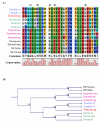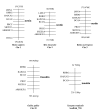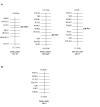Molecular evolution of type VI intermediate filament proteins
- PMID: 17854500
- PMCID: PMC2075511
- DOI: 10.1186/1471-2148-7-164
Molecular evolution of type VI intermediate filament proteins
Abstract
Background: Tanabin, transitin and nestin are type VI intermediate filament (IF) proteins that are developmentally regulated in frogs, birds and mammals, respectively. Tanabin is expressed in the growth cones of embryonic vertebrate neurons, whereas transitin and nestin are found in myogenic and neurogenic cells. Another type VI IF protein, synemin, is expressed in undifferentiated and mature muscle cells of birds and mammals. In addition to an IF-typical alpha-helical core domain, type VI IF proteins are characterized by a long C-terminal tail often containing distinct repeated motifs. The molecular evolution of type VI IF proteins remains poorly studied.
Results: To examine the evolutionary history of type VI IF proteins, sequence comparisons, BLAST searches, synteny studies and phylogenic analyses were performed. This study provides new evidence that tanabin, transitin and nestin are indeed orthologous type VI IF proteins. It demonstrates that tanabin, transitin and nestin genes share intron positions and sequence identities, have a similar chromosomal context and display closely related positions in phylogenic analyses. Despite this homology, fast evolution rates of their C-terminal extremity have caused the appearance of repeated motifs with distinct biological activities. In particular, our in silico and in vitro analyses of their tail domain have shown that (avian) transitin, but not (mammalian) nestin, contains a repeat domain displaying nucleotide hydrolysis activity.
Conclusion: These analyses of the evolutionary history of the IF proteins fit with a model in which type VI IFs form a branch distinct from NF proteins and are composed of two major proteins: synemin and nestin orthologs. Rapid evolution of the C-terminal extremity of nestin orthologs could be responsible for their divergent functions.
Figures







Similar articles
-
Molecular polymorphism of the intermediate filament protein transitin.Histochem Cell Biol. 2001 Nov;116(5):397-409. doi: 10.1007/s00418-001-0333-7. Epub 2001 Oct 9. Histochem Cell Biol. 2001. PMID: 11735004
-
Molecular cloning of a new intermediate filament protein expressed by radial glia and demonstration of alternative splicing in a novel heptad repeat region located in the carboxy-terminal tail domain.Mol Cell Neurosci. 1997;10(1-2):71-86. doi: 10.1006/mcne.1997.0627. Mol Cell Neurosci. 1997. PMID: 9361289
-
Characterization of the chicken transitin gene reveals a strong relationship to the nestin intermediate filament class.J Mol Neurosci. 1999 Feb;12(1):11-22. doi: 10.1385/JMN:12:1:11. J Mol Neurosci. 1999. PMID: 10636467
-
Fish intermediate filament proteins in structure, evolution, and function.Subcell Biochem. 1998;31:1-33. Subcell Biochem. 1998. PMID: 9932488 Review. No abstract available.
-
Intermediate filament proteins.Protein Profile. 1994;1(8):779-911. Protein Profile. 1994. PMID: 7634137 Review. No abstract available.
Cited by
-
Neurofilaments and Neurofilament Proteins in Health and Disease.Cold Spring Harb Perspect Biol. 2017 Apr 3;9(4):a018309. doi: 10.1101/cshperspect.a018309. Cold Spring Harb Perspect Biol. 2017. PMID: 28373358 Free PMC article. Review.
-
AMD3100 inhibits the migration and differentiation of neural stem cells after spinal cord injury.Sci Rep. 2017 Mar 6;7(1):64. doi: 10.1038/s41598-017-00141-8. Sci Rep. 2017. PMID: 28246405 Free PMC article.
-
High NESTIN Expression Marks the Endosteal Capillary Network in Human Bone Marrow.Front Cell Dev Biol. 2020 Dec 8;8:596452. doi: 10.3389/fcell.2020.596452. eCollection 2020. Front Cell Dev Biol. 2020. PMID: 33364234 Free PMC article.
-
α-Synemin localizes to the M-band of the sarcomere through interaction with the M10 region of titin.FEBS Lett. 2014 Dec 20;588(24):4625-30. doi: 10.1016/j.febslet.2014.11.001. Epub 2014 Nov 11. FEBS Lett. 2014. PMID: 25447537 Free PMC article.
-
Identification and cytoprotective function of a novel nestin isoform, Nes-S, in dorsal root ganglia neurons.J Biol Chem. 2013 Mar 22;288(12):8391-8404. doi: 10.1074/jbc.M112.408179. Epub 2013 Jan 14. J Biol Chem. 2013. PMID: 23319587 Free PMC article.
References
-
- Hesse M, Magin TM, Weber K. Genes for intermediate filament proteins and the draft sequence of the human genome: novel keratin genes and a surprisingly high number of pseudogenes related to keratin genes 8 and 18. J Cell Sci. 2001;114:2569–2575. - PubMed
-
- Parry DA. Microdissection of the sequence and structure of intermediate filament chains. Adv Protein Chem. 2005;70:113–142. - PubMed
Publication types
MeSH terms
Substances
LinkOut - more resources
Full Text Sources
Research Materials
Miscellaneous

